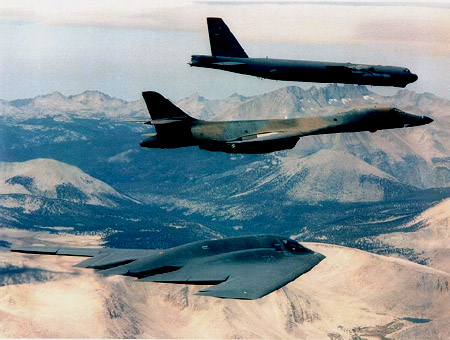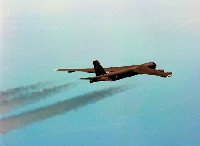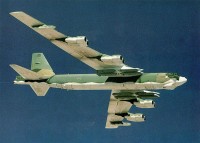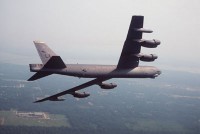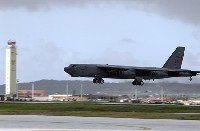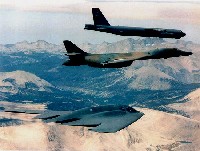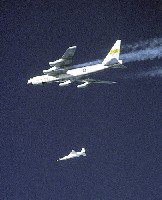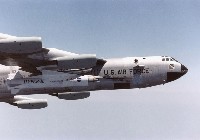|
Global Aircraft -- B-52 Stratofortress
Aviation Center
US Attack
US Bombers
US Cargo
US Fighters
US Helicopters
US Patrol/Pursuit
US Reconnaissance
US Tankers
US Trainers
US UAV's
US X Planes
Orbiter Vehicles
WWI Aircraft
WWII Aircraft
Airbus
Antonov
Boeing
Dassault
Ilyushin
Kamov
MiG
Mil
Saab
Sukhoi
Tupolev
Yakovlev
Joint/Rest of World
Entertainment Center
Members Center
New Technologies
Contact Us
Extra Navigation
GAC Engine
B-52 Stratofortress Specifications
B-52 Stratofortress Achievements
B-52 Stratofortress Features
In a conventional conflict, the B-52 can perform strategic attack, air interdiction, offensive counter-air and maritime operations. During Desert Storm, B-52s delivered 40 percent of all the weapons dropped by coalition forces. It is highly effective when used for ocean surveillance, and can assist the U.S. Navy in anti-ship and mine-laying operations. Two B-52s, in two hours, can monitor 140,000 square miles (364,000 square kilometers) of ocean surface. All B-52s are equipped with an electro-optical viewing system that uses platinum silicide forward-looking infrared and high resolution low-light-level television sensors to augment targeting, battle assessment, and flight safety, thus further improving its combat ability and low-level flight capability. Pilots wear night vision goggles (NVGs) to enhance their vision during night operations. Night vision goggles provide greater safety during night operations by increasing the pilot's ability to visually clear terrain, avoid enemy radar and see other aircraft in a covert/lights-out environment. Starting in 1989, on-going modifications incorporates the global positioning system, heavy stores adapter beams for carrying 2,000 pound munitions, and a full array of advance weapons currently under development. The use of aerial refueling gives the B-52 a range limited only by crew endurance. It has an unrefueled combat range in excess of 8,800 miles (14,080 kilometers). The aircraft's flexibility was evident in Operation Desert Storm and again during Operations Allied Force. B-52s struck wide-area troop concentrations, fixed installations and bunkers, and decimated the morale of Iraq's Republican Guard. The Gulf War involved the longest strike mission in the history of aerial warfare when B-52s took off from Barksdale Air Force Base, La., launched conventional air launched cruise missiles and returned to Barksdale -- a 35-hour, non-stop combat mission. . During Operation Allied Force, B-52s opened the conflict with conventional cruise missile attacks and then transitioned to delivering general purpose bombs and cluster bomb units on Serbian army positions and staging areas. Source: http://www.af.mil
B-52 Stratofortress Background
The B-52 first entered service in June 1955, now only 2 versions remain in service with its successor, ACC. A total of 193 J57 powered B-52G were built with integral wing tanks and short fin, and armed with four 0.50-in machine guns. In desert Storm, all missions were assigned to the G model, operating as free-fall bombers. The B-52G is well protected by numerous ECM systems, and 2 under nose 'blisters' house LLLTV and FLIR sensors - used with the terrain avoidance radar to provide low-level penetration capability. Some B-52 were used in many aircraft testing as motherships to carry them up to testing altitude, such as the X-15 program. Summary Copyright © Charles M (JetWhiz) | ||||||||||||||||||||||||||||||||||||||||||||||
